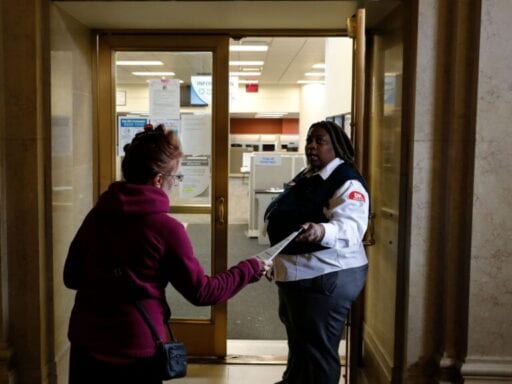A terrifying forecast from the Congressional Budget Office.
A surprisingly strong May jobs report suggests that the bounce back from the Covid-19 recession started faster than most analysts were expecting. But that doesn’t mean the economy is out of the woods.
In the early stages of a recovery, promising economic signs, like improved employment numbers, could mean the US is on track to returning to pre-recession levels of economic activity. Or those signs could just point to a partial recovery, one that stalls out at 70, 80, or even 90 percent — all of which would still indicate serious recession conditions.
Unfortunately, a partial turnaround is exactly what the Congressional Budget Office’s May macroeconomic forecast says the country should expect — followed by an extended slog toward actual recovery.
In fact, the CBO is projecting that inflation-adjusted gross domestic product won’t return to its pre-pandemic trend level until 2030. So it’s looking like a situation where unemployment remains elevated for nearly a decade, and the country as a whole ends up trillions of dollars poorer.
But that’s not an inevitability, it’s a choice. As the CBO states, “If future federal policies differ from those underlying CBO’s economic projections—for example, if lawmakers enact additional pandemic-related legislation—then economic outcomes will necessarily differ from those presented here.”
We shouldn’t accept one or two months of good news as a substitute for a real strategy of full recovery. Congress responded to the initial Covid-19 shock by passing multiple bills that have done a lot to help. But it’s much too soon to give up or declare mission accomplished.
The CBO says the US will bounce back — partially
In the below chart, the CBO shows the difference between what it is currently forecasting for the economy versus what it forecasted before the pandemic.
The expectation is that there will be a rapid recovery for a couple of quarters that then starts to slow before full recovery is reached. Inflation-adjusted (“real” in the chart) economic activity will remain below its pre-pandemic trend for 10 years, and nominal activity will essentially never recover.
/cdn.vox-cdn.com/uploads/chorus_asset/file/20020782/Screen_Shot_2020_06_05_at_11.38.10_AM.png) Congressional Budget Office
Congressional Budget OfficeMost people have long-term economic obligations — like rent, cell phone or internet bills, mortgages, auto loans, or student loans — that are specified in nominal terms. Some of these obligations are factored into the inflation price calculus, but debt repayment is not. So a world where nominal incomes are lower is still a world in which everyone who owes money on a car, a house, or a student loan has a problem even if inflation is also low.
Meanwhile, that real economic activity will lag somewhat behind pre-pandemic forecasts is, to an extent, inevitable. The coronavirus itself destroyed resources in the form of lost lives and damaged lungs in survivors of the disease. Buildings and business equipment that were not constructed or maintained during the lockdowns can’t be magically summoned into existence. And for the foreseeable future, the country is going to be expending a fair amount of extra effort on producing durable sanitary and personal protective equipment, erecting plexiglass barriers in stores, and otherwise just trying to dig out from the impact of Covid-19.
But this is not a forecast of America suffering the inevitable burden of a pandemic. It’s a forecast of the country performing much worse than it could.
An under-stimulated economy
A key sign that more legislation to address the economic emergency would help is that nominal GDP trends are much worse than the inflation-adjusted ones. In an over-stimulated economy, inflation soars as spending levels exceed the economy’s ability to actually produce things.
America is currently not on track toward that.
It’s on track toward an economy that remains depressed even as virus-related problems abate, because lost income during the crisis stops households and local governments from spending money.
The good news is that compared to finding a cure for Covid-19, this is a relatively simple problem to solve. The federal government could give cheap loans to small businesses, while flushing cash out to state and local governments and individual households. If it does that, spending levels would grow alongside the ability to do things safely, with perhaps a moderate amount of inflation as retailers pass on the cost of special Covid-19 safety measures.
But it won’t happen if Congress lets the good news from the initial strong bounce back eliminate all sense of urgency.
Support Vox’s explanatory journalism
Every day at Vox, we aim to answer your most important questions and provide you, and our audience around the world, with information that has the power to save lives. Our mission has never been more vital than it is in this moment: to empower you through understanding. Vox’s work is reaching more people than ever, but our distinctive brand of explanatory journalism takes resources — particularly during a pandemic and an economic downturn. Your financial contribution will not constitute a donation, but it will enable our staff to continue to offer free articles, videos, and podcasts at the quality and volume that this moment requires. Please consider making a contribution to Vox today.
Author: Matthew Yglesias
Read More



